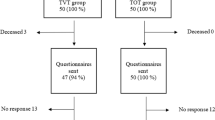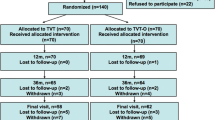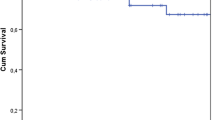Abstract
We evaluated the outcome at least 6 months after tension-free vaginal tape (TVT), suprapubic arc (SPARC) sling, or transobturator tape (TOT) procedure in women with mixed urinary incontinence and identified factors predicting the outcome in these patients. A total of 144 women, 29 to 77 years old (mean age 57.3), were included in the study; TVT (n = 72), SPARC (n = 22), and TOT (n = 50). The mean follow-up time was 10.9 months (range 6 to 52). There were no significant differences in the three groups in terms of the cure rate for stress urinary incontinence (SUI; TVT, 95.8%; SPARC, 90.0%; TOT, 94.0%; P = 0.625) and urinary incontinence (UUI; TVT, 81.9%; SPARC, 86.4%; TOT, 82.0%; P = 0.965). In the multivariate model, there is no influencing factor for treatment failure of SUI, while maximum urethral closure pressure (MUCP) and the diagnosis of uninhibited detrusor contraction during cystometry were independent risk factors for treatment failure of UUI. Decreasing MUCP was associated with an increased likelihood of treatment failure of UUI [odds ratio (OR), 0.974; 95% confidence interval (CI), 0.950–0.998; P = 0.034]. In the same model, uninhibited detrusor contraction was associated with 3.4-fold risk of treatment failure of UUI (OR, 3.351; 95% CI, 1.031–10.887; P = 0.044). Our findings suggest that low MUCP and the presence of uninhibited detrusor contraction during cystometry should be considered to be at high risk of treatment failure of UUI after surgery in these patients.
Similar content being viewed by others
References
Abrams P, Cardozo L, Fall M et al (2002) The standardisation of terminology of lower urinary tract function: report from the standardisation sub-committee of the International Continence Society. Neurourol Urodyn 21:167–178
Ulmsten U, Henriksson L, Johnson P, Varhos G (1996) An ambulatory surgical procedure under local anesthesia for treatment of female urinary incontinence. Int Urogynecol J Pelvic Floor Dysfunct 7:81–85
Petros PE, Ulmsten UI (1993) An integral theory and its method for the diagnosis and management of female urinary incontinence. Scand J Urol Nephrol Suppl 153:1–93
Deval B, Levardon M, Samain E et al (2003) A French multicenter clinical trial of SPARC for stress urinary incontinence. Eur Urol 44:254–258
Delorme E, Droupy S, de Tayrac R, Delmas V (2004) Transobturator tape (Uratape): a new minimally-invasive procedure to treat female urinary incontinence. Eur Urol 45:203–207
Ankardal M, Heiwall B, Lausten-Thomsen N, Carnelid J, Milsom I (2006) Short- and long-term results of the tension-free vaginal tape procedure in the treatment of female urinary incontinence. Acta Obstet Gynecol Scand 85:986–992
Kuuva N, Nilsson CG (2006) Long-term results of the tension-free vaginal tape operation in an unselected group of 129 stress incontinent women. Acta Obstet Gynecol Scand 85:482–487
Ingelman-Sundberg A, Ulmsten U (1983) Surgical treatment of female urinary stress incontinence. Contrib Gynecol Obstet 10:51–69
Juma S, Little NA, Raz S (1993) Evaluation of stress urinary incontinence. In: Buchsbaum HJ, Schmidt JD (eds) Gynecologic and obstetric urology. Saunders, Philadelphia, pp 251–263
Rezapour M, Ulmsten U (2001) Tension-free vaginal tape (TVT) in women with mixed urinary incontinence: a long-term follow-up. Int Urogynecol J Pelvic Floor Dysfunct 12(Suppl 2):S15–S18
Segal JL, Vassallo B, Kleeman S, Silva WA, Karram MM (2004) Prevalence of persistent and de novo overactive bladder symptoms after the tension-free vaginal tape. Obstet Gynecol 104:1263–1269
Holmgren C, Nillson S, Lanner L, Helberg D (2005) Long-term results with tension-free vaginal tape on mixed and stress urinary incontinence. Obstet Gynecol 106:38–43
Kulseng-Hanssen S, Husby H, Schiotz HA (2007) The tension free vaginal tape operation for women with mixed incontinence: do preoperative variables predict the outcome? Neurourol Urodyn 26:115–121
Paick JS, Ku JH, Kim SW, Oh SJ, Son H, Shin JW (2004) Tension-free vaginal tape procedure for the treatment of mixed urinary incontinence: significance of maximal urethral closure pressure. J Urol 172:1001–1005
Duckett JR, Tamilselvi A (2006) Effect of tension-free vaginal tape in women with a urodynamic diagnosis of idiopathic detrusor overactivity and stress incontinence. BJOG 113:30–33
Fulford SC, Flynn R, Barrington J, Appanna T, Stephenson TP (1999) An assessment of the surgical outcome and urodynamic effects of the pubovaginal sling for stress incontinence and the associated urge syndrome. J Urol 162:135–137
McLennan MT, Melick C, Bent AE (2001) Urethral instability: clinical and urodynamic characteristics. Neurourol Urodyn 20:653–660
Webster GD, Sihelnik SA, Stone AR (1984) Female urinary incontinence: the incidence, identification, and characteristics of detrusor instability. Neurourol Urodyn 3:235–241
Petros PE, Ulmsten U (1993) Bladder instability in women: a premature activation of the micturition reflex. Neurourol Urodyn 12:235–239
Major H, Culligan P, Heit M (2002) Urethral sphincter morphology in women with detrusor instability. Obstet Gynecol 99:63–68
Awad S, McGinnis R (1983) Factors that influence the incidence of detrusor instability in women. J Urol 130:114–115
Bump RC, Norton PA, Zinner NR, Yalcin I, Duloxetine Urinary Incontinence Study Group (2003) Mixed urinary incontinence symptoms: urodynamic findings, incontinence severity, and treatment response. Obstet Gynecol 102:76–83
Author information
Authors and Affiliations
Corresponding author
Rights and permissions
About this article
Cite this article
Paick, JS., Oh, SJ., Kim, S.W. et al. Tension-free vaginal tape, suprapubic arc sling, and transobturator tape in the treatment of mixed urinary incontinence in women. Int Urogynecol J 19, 123–129 (2008). https://doi.org/10.1007/s00192-007-0401-1
Received:
Accepted:
Published:
Issue Date:
DOI: https://doi.org/10.1007/s00192-007-0401-1




